This 'Remarkable' Galaxy Is On A Course Toward The Earth

A new photo taken by the Hubble Space Telescope shows a galaxy, Messier 90, coming closer toward the Earth. The spiral galaxy is at a distance of about 60 million light-years from our Milky Way and its trajectory toward our home planet is rare in an expanding Universe.
A statement from Hubble describes Messier 90 as "remarkable." It says that it is one of the few galaxies seen to be traveling toward the Milky Way. “The galaxy’s light reveals this incoming motion in that it is blueshifted,” it said. In other words, the galaxy is compressing the wavelength of its light and shifts it toward the blue end of the spectrum. “As our universe is expanding, almost all of the galaxies we see in the universe are moving away from us, and we therefore see their light as redshifted, but Messier 90 appears to be a rare exception,” the statement explained.
Messier 90 , according to the official Messier platform, is a spiral galaxy is located in the constellation Virgo. Scientists describe Messier 90 as one of the largest and brightest spirals in the Virgo Cluster. “The galaxy has an absolute magnitude of -22, which makes it intrinsically brighter than Andromeda (M31),” it said.
Messier 90 is home to about a trillion stars and has a rich population of globular clusters. Scientists believe that it interacts with a satellite galaxy.
But if you are looking for an alien-related explanation for this unusual course for Messier 90, astronomers have a more prosaic and probable reason. Astronomers, according to Sci-News, are of the view that the blueshift is caused by the colossal mass of the Virgo cluster accelerating its members to high velocities on bizarre and peculiar objects, sending them whirling around on paths that take them both toward and away from us over time.
“The constituent galaxies such as Messier 90 are moving faster than the cluster as a whole, making it so that from Earth, we see the galaxy heading straight towards us,” the European Space Agency said.
The best time to view Messier 90 is in May, when it can be seen with binoculars in a clear, dark sky.
© Copyright IBTimes 2024. All rights reserved.





















